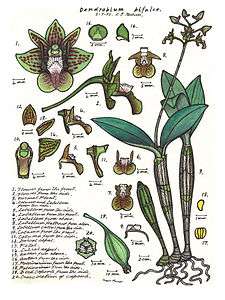Dendrobium bifalce
Dendrobium bifalce, commonly known as the native bee orchid,[2] is an epiphytic or lithophytic orchid in the family Orchidaceae. It has spindle-shaped pseudobulbs with up to four leathery leaves and up to ten pale green or greenish yellow flowers with purplish markings. It grows on trees and boulders in rainforest in tropical North Queensland, Australia and in New Guinea.

| Native bee orchid | |
|---|---|
_Lindl.%2C_London_J._Bot._2-_237_(1843)_(32965396955)_-_cropped.jpg) | |
| Scientific classification | |
| Kingdom: | Plantae |
| Clade: | Tracheophytes |
| Clade: | Angiosperms |
| Clade: | Monocots |
| Order: | Asparagales |
| Family: | Orchidaceae |
| Subfamily: | Epidendroideae |
| Tribe: | Dendrobieae |
| Subtribe: | Dendrobiinae |
| Genus: | Dendrobium |
| Species: | D. bifalce |
| Binomial name | |
| Dendrobium bifalce | |
| Synonyms[1] | |
| |
Description
Dendrobium bifalce is an epiphytic or lithophytic orchid with furrowed, spindle-shaped, yellowish or purplish pseudobulbs 200–400 mm (8–20 in) long and 20–25 mm (0.8–1 in) wide. Each pseudobulb has between two and four leathery, egg-shaped leaves 100–150 mm (4–6 in) long and 40–50 mm (1.6–2.0 in) wide. The flowering stems are 150–250 mm (6–10 in) long with between five and ten green or greenish yellow flowers with purplish markings. The flowers are 25–30 mm (0.98–1.2 in) long and wide with broad, fleshy sepals and petals. The dorsal sepal is egg-shaped, more or less upright, 8–10 mm (0.31–0.39 in) long and about 7 mm (0.28 in) wide. The lateral sepals are lance-shaped, 9–11 mm (0.4–0.4 in) long, 7–8 mm (0.3–0.3 in) wide and spread widely apart from each other. The petals are lance-shaped, 8–10 mm (0.3–0.4 in) long and about 4 mm (0.2 in) wide. The labellum is about 12 mm (0.5 in) long, 8 mm (0.3 in) wide and has three lobes. The side lobes are sickle-shaped and curve upwards and the middle lobe has a narrowed middle and a warty ridge along its midline. Flowering occurs from April to July.[2][3][4]
Taxonomy and naming
Dendrobium bifalce was first formally described in 1843 by John Lindley from a specimen collected in New Guinea by Richard Brinsley Hinds.[5][6] The specific epithet (bifalce) is a derived from the Latin bi- meaning "two"[7]:141 and falce meaning "sickles".[7]:315
Distribution and habitat
The native bee orchid grows on boulders and trees in rainforest in New Guinea and in Australia from the Torres Strait Islands to the Daintree National Park.[2][3][4]
References
- "Dendrobium bifalce". World Checklist of Selected Plant Families (WCSP). Royal Botanic Gardens, Kew.
- Jones, David L. (2006). A complete guide to native orchids of Australia including the island territories. Frenchs Forest, N.S.W.: New Holland. p. 384. ISBN 1877069124.
- "Leioanthum bifalce". Trin keys: Australian Tropical Rainforest Orchids. Retrieved 15 November 2018.
- "Dendrobium bifalce". Orchids of New Guinea. Retrieved 15 November 2018.
- "Dendrobium bifalce". APNI. Retrieved 15 November 2018.
- Lindley, John (1843). "Vegetation of the Feejee Islands". London Journal of Botany. 2: 237. Retrieved 15 November 2018.
- Brown, Roland Wilbur (1956). The Composition of Scientific Words. Washington, D.C.: Smithsonian Institution Press.